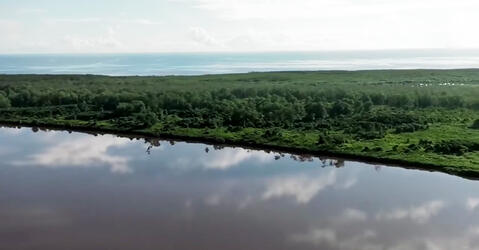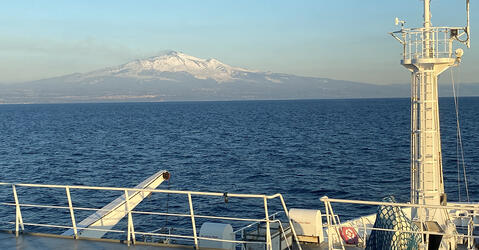You are here
Transcript
Close
Viruses that rule the oceans
For the last fifteen years – twice a month, these researchers anchor near Roscoff just off the coasts of Brittany.
They are always sure to get a good catch – in these seawater samples.
They are fishing for plankton, marine micro-organisms which move with the currents ; micro-algae, bacteria, and the lesser known marine viruses.
Ignored by Science for many years, marine viruses are the planet’s most abundant biological entities…
ITV Anne Claire Baudoux, Biologist
We only started studying the viruses 25 years ago – because we didn’t see, well, look at them before. Because viruses are much smaller than the other living organisms, so they were overlooked for years. And the day we realised that the viruses were 10 times more abundant than bacteria, and 100 times more abundant than micro-algae in the oceans, we wondered what role they could play in the environment.
According to some definitions, a virus is not even considered as a living organism. In order to reproduce, these tiny parasites must infect fully functional organisms. By injecting their genetic material, the viruses hack into their host’s cellular machinery, which then becomes a virus-producing machine – often until the cell bursts.
Viruses are tremendous predators infecting and killing up to 40% of the ocean’s bacteria each and every day.
They also attack diatoms, widespread microscopic algae, and the first link in the food chain.
ITV
Diatoms are very important micro-algae in the ocean, because they develop peaks of biomass – what we call blooms, and during these micro-algae blooms, there is a substantial proportion of atmospheric CO2 which will be captured by the oceans, thanks to these micro-algae, through photosynthesis – and so it’s important to see how these micro-algae are regulated, so that we can better understand these carbon budgets and these cycles of matter in the ocean.
And so we try to understand the role viruses play in regulating these diatoms.
After trip out to sea, the researchers bring their catch back to the laboratory. One of their goals is to identify new viral strains and try to understand how they interact with their hosts.
SOT Laure Arsenieff, Ph.D student
“Here, we are going to take the water we have just sampled and filter it to collect all the viruses, and after put them directly in contact with their different types of hosts…”
A virus is unable to attack all living beings – like most parasites, they are very selective. It is by putting their virus samples in contact with isolated micro-algae that they can determine the number of hosts a virus can infect and study the life cycles of these parasites.
ITV
I’m looking at the algae cultures to see if they are doing well, if they are developing well, because it’s really important to have cultures that are growing well in order to optimise the chances of isolating a virus. We need a host that is doing well for a virus to effectively replicate and multiply.
So, in general, we look through a microscope and then we look at the colour of the cultures. Here we can see that it’s a rich yellow, the cultures are shiny… they are really beautiful.
After a few days of incubation with the right algae, the result killing power of the virus is quite remarkable.
So, here we have a culture of green micro-algae, without a virus, and here, it’s the same algae which was infected with a virus the day before yesterday. And you can clearly see the difference. In this case, the virus has disintegrated the algae and has multiplied in the culture medium.
Once the virus has been isolated and cultured, it can be described – the team uses an electronic microscope to observe the shape and size of such small organisms.
So, if we zoom, we see that these viruses have a hexagonal shape, that they are nevertheless quite large, and here we see a membrane that contains the DNA of viruses. And so we can classify them in the Phycodnaviridae family.
For a more accurate classification, the virus genome is also sequenced. This will provide the virus’ genetic fingerprint. This profile can then be used to locate the virus within the extensive DNA databases obtained from seawater micro-organisms sampled all around the world.
We “go fishing” – we have a sequence, so we look to see whether or not it is present in the environment. And as there are a considerable number of samples that have been collected throughout the oceans, we can look at these databanks one by one and see if our sequence is present or not, and this allows us to map the distribution of our virus.
Thanks to recent technological advances marine virology has become a particularly vibrant field of science. Many questions still remain unanswered, like the role that these tiny and pervasive parasites play on the Earth’s climate…
The viruses that rule the oceans
Featuring
Anne-Claire Baudoux
Laure Arsenieff
Roscoff Marine Station
CNRS / UPMC
Photography and sound
Juliette Lacharnay
Journalists
Juliette Lacharnay and Cécile Khindria
Editing
Christophe Lebon and Nicolas Baker
Sound Mixing
Thomas Huguet
Editor in chief
Nicolas Baker
Images
Archives
Images of plancton from the film Chroniques du plancton directed by Christian Sardet (CNRS / Tara océans)
Virus animation from the film
Danger Virus produced by Mona Lisa Production and CNRS Images
All rights reserved
Music
Shipwreck Hunting
Composed by Frédéric Dunis and Bernard Grimaldi
With kind permission from Cezame Music Agency
All rights reserved
A CNRS IMAGES production
© CNRS Images 2016
For the last fifteen years – twice a month, these researchers anchor near Roscoff just off the coasts of Brittany.
They are always sure to get a good catch – in these seawater samples.
They are fishing for plankton, marine micro-organisms which move with the currents ; micro-algae, bacteria, and the lesser known marine viruses.
Ignored by Science for many years, marine viruses are the planet’s most abundant biological entities…
ITV Anne Claire Baudoux, Biologist
We only started studying the viruses 25 years ago – because we didn’t see, well, look at them before. Because viruses are much smaller than the other living organisms, so they were overlooked for years. And the day we realised that the viruses were 10 times more abundant than bacteria, and 100 times more abundant than micro-algae in the oceans, we wondered what role they could play in the environment.
According to some definitions, a virus is not even considered as a living organism. In order to reproduce, these tiny parasites must infect fully functional organisms. By injecting their genetic material, the viruses hack into their host’s cellular machinery, which then becomes a virus-producing machine – often until the cell bursts.
Viruses are tremendous predators infecting and killing up to 40% of the ocean’s bacteria each and every day.
They also attack diatoms, widespread microscopic algae, and the first link in the food chain.
ITV
Diatoms are very important micro-algae in the ocean, because they develop peaks of biomass – what we call blooms, and during these micro-algae blooms, there is a substantial proportion of atmospheric CO2 which will be captured by the oceans, thanks to these micro-algae, through photosynthesis – and so it’s important to see how these micro-algae are regulated, so that we can better understand these carbon budgets and these cycles of matter in the ocean.
And so we try to understand the role viruses play in regulating these diatoms.
After trip out to sea, the researchers bring their catch back to the laboratory. One of their goals is to identify new viral strains and try to understand how they interact with their hosts.
SOT Laure Arsenieff, Ph.D student
“Here, we are going to take the water we have just sampled and filter it to collect all the viruses, and after put them directly in contact with their different types of hosts…”
A virus is unable to attack all living beings – like most parasites, they are very selective. It is by putting their virus samples in contact with isolated micro-algae that they can determine the number of hosts a virus can infect and study the life cycles of these parasites.
ITV
I’m looking at the algae cultures to see if they are doing well, if they are developing well, because it’s really important to have cultures that are growing well in order to optimise the chances of isolating a virus. We need a host that is doing well for a virus to effectively replicate and multiply.
So, in general, we look through a microscope and then we look at the colour of the cultures. Here we can see that it’s a rich yellow, the cultures are shiny… they are really beautiful.
After a few days of incubation with the right algae, the result killing power of the virus is quite remarkable.
So, here we have a culture of green micro-algae, without a virus, and here, it’s the same algae which was infected with a virus the day before yesterday. And you can clearly see the difference. In this case, the virus has disintegrated the algae and has multiplied in the culture medium.
Once the virus has been isolated and cultured, it can be described – the team uses an electronic microscope to observe the shape and size of such small organisms.
So, if we zoom, we see that these viruses have a hexagonal shape, that they are nevertheless quite large, and here we see a membrane that contains the DNA of viruses. And so we can classify them in the Phycodnaviridae family.
For a more accurate classification, the virus genome is also sequenced. This will provide the virus’ genetic fingerprint. This profile can then be used to locate the virus within the extensive DNA databases obtained from seawater micro-organisms sampled all around the world.
We “go fishing” – we have a sequence, so we look to see whether or not it is present in the environment. And as there are a considerable number of samples that have been collected throughout the oceans, we can look at these databanks one by one and see if our sequence is present or not, and this allows us to map the distribution of our virus.
Thanks to recent technological advances marine virology has become a particularly vibrant field of science. Many questions still remain unanswered, like the role that these tiny and pervasive parasites play on the Earth’s climate…
The viruses that rule the oceans
Featuring
Anne-Claire Baudoux
Laure Arsenieff
Roscoff Marine Station
CNRS / UPMC
Photography and sound
Juliette Lacharnay
Journalists
Juliette Lacharnay and Cécile Khindria
Editing
Christophe Lebon and Nicolas Baker
Sound Mixing
Thomas Huguet
Editor in chief
Nicolas Baker
Images
Archives
Images of plancton from the film Chroniques du plancton directed by Christian Sardet (CNRS / Tara océans)
Virus animation from the film
Danger Virus produced by Mona Lisa Production and CNRS Images
All rights reserved
Music
Shipwreck Hunting
Composed by Frédéric Dunis and Bernard Grimaldi
With kind permission from Cezame Music Agency
All rights reserved
A CNRS IMAGES production
© CNRS Images 2016
The Viruses that Rule our Oceans
07.08.2016
Every day, marine viruses kill 40% of our oceans’ bacteria. And yet these biological entities are still poorly known. For example, we still know little about their role in the regulation of microalgae, the first link in the food chain that also produces close to a quarter of our planet’s oxygen. We travel to the Roscoff Marine Station to see how researchers there are trying to isolate, and better understand these fearsome predators.
About this video
Original title:
The viruses that rule the oceans
Production year:
2016
Length:
5 min 50
Director:
Juliette Lacharnay and Nicolas Baker
Producer:
CNRS Images
Speaker(s) :
Anne-Claire Baudoux
Laure Arsenieff
Roscoff Marine Station
CNRS / UPMC
Laure Arsenieff
Roscoff Marine Station
CNRS / UPMC
Journalist(s) :
Juliette Lacharnay and Cécile Khindria
Recent videos
Video





